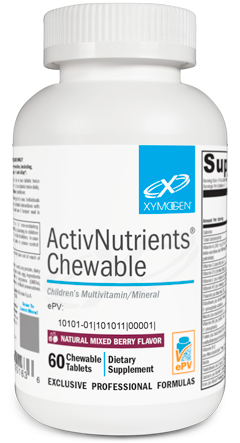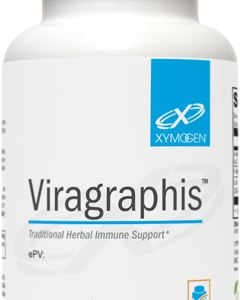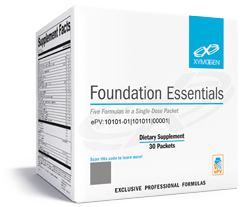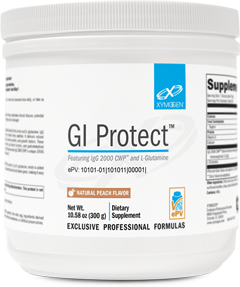Scientific Information/Data
Good nutrition in childhood and adolescence is essential for achieving optimal growth and normal development. It also greatly impacts overall health and well-being, including resistance to infection and achieving peak bone mass.[1] Not only does good nutrition impact health, but it also influences socialization, self-esteem, and academic performance.[2,3] Unfortunately, the diets of many American children fall considerably short of recommended dietary standards.[4] For instance, vitamins A, C, D, and E as well as folate, calcium, and magnesium are all underconsumed relative to the estimated average requirements (EARs).[5]
Finding a children’s multiple that comprises nutrients in their most highly absorbable form, such as 5-MTHF instead of folic acid[6,7]; is free of toxic additives and preservatives; and tastes great without using corn syrup can be very challenging. XYMOGEN has met this challenge with ActivNutrients Chewable.
Clean ActivNutrients Chewable is free of the common allergens wheat, gluten, yeast, soy protein, dairy products, fish, shellfish, peanuts, tree nuts, and egg. It does not contain hydrogenated oils, dyes, artificial colors, or other additives, such as high-fructose corn syrup; nor does it contain artificial flavors, sweeteners, or preservatives.
Quality, Naturally ActivNutrients Chewable micronutrients are provided in bioavailable forms so that they can be better absorbed and utilized. The formula features a full complement of Albion® patented mineral chelates and complexes.[8] It not only provides natural vitamin E, which has been proven to be up to 100% more bioavailable than synthetic dlalpha-tocopherol, but it also delivers mixed tocopherols to more closely approximate how one might consume vitamin E in healthful foods.[9,10]Folate is provided as Quatrefolic—5-methyltetrahydrofolate (5-MTHF) glucosamine salt. 5-MTHF is the most bioactive form of folate.[11] K2 is delivered in the form of menaquinone-7. Vitamin B12 is provided as MecobalActive™, a form of methylcobalamin that has very high purity; no harmful solvents are used in its production.[12] Vitamins B2 and B6 are also provided in activated forms.*
Taste To get children to take a supplement, it must taste good. The mixed berry flavor makes it easy to incorporate ActivNutrients Chewable into kids’ daily routines; they will never notice all the great B vitamins and other micronutrients they are getting. Its delicious blend of blackberry, blueberry, strawberry, raspberry, and cherry flavors has the perfect balance of sweetness and tartness–one doesn’t overpower the other. There’s also no stevia. ActivNutrients Chewable is sweetened by xylitol and monk fruit extract.*[13]
Complete Many vitamins and minerals work synergistically and cooperatively. ActivNutrients Chewable features a 23-nutrient profile that includes calcium and magnesium, zinc and copper, vitamins C and E, B vitamin complex, beta-carotene, and trace elements.*
Divided Dosing Unlike one-a-day multivitamins, ActivNutrients Chewable doses can be divided throughout the day to allow better utilization of the nutrients. This is particularly important for water-soluble nutrients like vitamin C and the B vitamins.*
Energy Production Kids need energy to perform well in school and keep up with their extracurricular activities. ActivNutrients Chewable provides generous levels of B vitamins, which serve as prime coenzymes in glycolysis and oxidative phosphorylation and as cofactors in amino acid and lipid metabolism. Many functional medicine practitioners believe that the balanced presence of B vitamins is essential to their cooperative functioning.*
Antioxidant Protection Vitamins E and C, selenium, zinc, trace elements, and 1,275 mg of mixed carotenoids (beta-carotene, alpha-carotene, lutein, lycopene, and zeaxanthin) provide broad-spectrum antioxidant activity. The combined presence of all of these nutrients supports their ability to regenerate each other and maintain consistent levels of antioxidant activity both intra- and extracellularly.*
*These statements have not been evaluated by the Food and Drug Administration. This product is not intended to diagnose, treat, cure, or prevent any disease.
References
1. Story M, Stang J. Nutrition Needs in Adolescents. In: Stang J, Story M, eds. Guidelines for Adolescent Nutrition Services. Minneapolis, MN: Center for Leadership, Education and Training in Maternal and Child Nutrition, Division of Epidemiology and Community Health, School of Public Health, University of Minnesota; 2005. http://www.epi.umn.edu/let/pubs/img/adol_ch3.pdf. Accessed February 21, 2017.
2. Nutrition-Related Health Concerns, Dietary Intakes, and Eating Behaviors of Children and Adolescents. In: Stallings V, Yaktine A, eds. Nutrition Standards for Foods in Schools: Leading the Way Toward Healthier Youth. Washington, DC: The National Academies Press; 2007. http://www.nap.edu/read/11899/chapter/4. Accessed February 21, 2017.
3. Stuber, N. Nutrition and Students’ Academic Performance. Saint Paul, MN: Wilder Research; January 2014. https://www.wilder.org/Wilder-Research/ Publications/Studies/Fueling%20Academic%20Performance%20-%20 Strategies%20to%20Foster%20Healthy%20Eating%20Among%20Students/ Nutrition%20and%20Students’%20Academic%20Performance.pdf. Accessed February 21, 2017.
4. Stallings V, Yaktine A, eds. Nutrition Standards for Foods in Schools: Leading the Way Toward Healthier Youth. Washington, DC: The National Academies Press; 2007. http://www.nap.edu/read/11899/chapter/1. Accessed August 8, 2016.
5. US Department of Agriculture. Part D. Chapter 1: Food and Nutrient Intakes, and Health: Current Status and Trends. In: Scientific Report of the 2015 Dietary Guidelines Advisory Committee. https://health.gov/dietaryguidelines/2015- scientific-report/PDFs/06-Part-D-Chapter-1.pdf. Accessed February 21, 2017.
6. Scaglione F, Panzavolta G. Folate, folic acid and 5-methyltetrahydrofolate are not the same thing. Xenobiotica. 2014 May;44(5):480-88. [PMID: 24494987]
7. Miraglia N, Agostinetto M, Bianchi D, et al. Enhanced oral bioavailability of a novel folate salt: comparison with folic acid and a calcium folate salt in a pharmacokinetic study in rats. Minerva Ginecol. 2016 Apr;68(2):99-105. [PMID: 27008238]
8. TRAACS®: The real amino acid chelate system. Albion® Research Notes. http:// www.albionhumannutrition.com/research-notes/134-traacsr-the-real-aminoacid-chelate-system. Accessed February 21, 2017.
9. Kiyose C, Muramatsu R, Kameyama Y, et al. Biodiscrimination of alphatocopherol stereoisomers in humans after oral administration. Am J Clin Nutr. 1997 Mar;65(3):785-89. [PMID: 9062530]
10. Burton GW, Traber MG, Acuff RV, et al. Human plasma and tissue alphatocopherol concentrations in response to supplementation with deuterated natural and synthetic vitamin E. Am J Clin Nutr. 1998 Apr;67(4):669-84. [PMID: 9537614]
11. Venn BJ, Green TJ, Moser R, et al. Comparison of the effect of low-dose supplementation with L-5-methyltetrahydrofolate or folic acid on plasma homocysteine: a randomized placebo-controlled study. Am J Clin Nutr. 2003 Mar;77(3):658-62. [PMID: 12600857]
12. Sallares J, Petschen I, Camps X, inventors; Ferrar Internacional, S.A., applicant. Process for the production of methylcobalamin. International publication number [English] WO 2006100059 A1. September 28, 2006.
13. Li XE, Lopetcharat K, Drake MA. Parents’ and children’s acceptance of skim chocolate milks sweetened by monk fruit and stevia leaf extracts. J Food Sci.2015 May;80(5):S1083-92. [PMID: 25847181]








Reviews
There are no reviews yet.